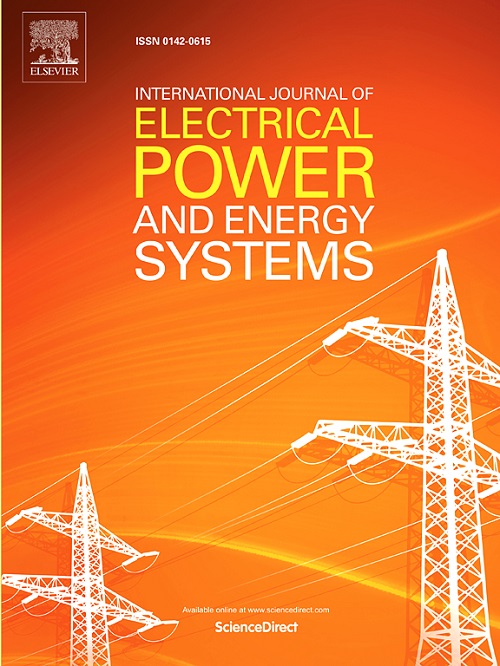可再生能源社区集热器的最优能源管理策略
IF 5
2区 工程技术
Q1 ENGINEERING, ELECTRICAL & ELECTRONIC
International Journal of Electrical Power & Energy Systems
Pub Date : 2025-09-17
DOI:10.1016/j.ijepes.2025.111085
引用次数: 0
摘要
可再生能源社区(RECs)最初是在欧洲指令中引入的,最近被纳入意大利的法律框架,它被描述为一种创新组织,可以根据创造性的管理方案,促进参与本地生产能源的生产、共享和消费的主动和被动用户之间的合作。本研究的目的是实施混合整数线性规划(MILP)模型,为管理REC的集成商构建能源管理系统(ems)。REC包括可再生能源(RESs)、电池储能系统(BESSs)、电动汽车(ev)的交流和直流充电点,并考虑使用车辆到建筑物(V2B)。具体来说,由聚合器管理的“集中式”EMS的目标是最大化REC内共享的能量,同时最大限度地减少BESS和EV电池的退化。与电网有功交换的最佳轮廓作为参考输入提供给本地用户的EMSs。考虑了两种情景,分别是5月和12月的一周,以研究不同的可再生能源生产和电力需求对能源共享机制的影响。通过定义适当的关键绩效指标(kpi),本研究表明分布式能源技术的优化运行可以提高REC绩效,导致共享能源指数(SEI)在5月份的考虑周达到92.42%。考虑到季节中期(3月和10月),进一步的场景进行了调查,并分析了最大化共享能量和最小化bess和电动汽车电池退化之间的权衡。最后,通过对多个场景的分析,研究了用户合作或非合作行为对全球能源共享的影响,包括不同的集中EMS对REC成员行为的认识以及合作/非合作用户的配置。本文章由计算机程序翻译,如有差异,请以英文原文为准。
Optimal energy management strategies for aggregators in renewable energy communities
First introduced in European directives and recently incorporated into the Italian legal framework, Renewable Energy Communities (RECs) are described as innovative organisations that can promote collaboration between active and passive users engaged in the production, sharing and consumption of locally produced energy, according to creative management schemes. The aim of this study is the implementation of Mixed-Integer Linear Programming (MILP) models to build Energy Management Systems (EMSs) for an aggregator managing a REC. The REC includes Renewable Energy Sources (RESs), Battery Energy Storage Systems (BESSs), AC and DC charging points for Electric Vehicles (EVs), and also considers the use of Vehicle-to-Building (V2B). Specifically, the “Centralised” EMS managed by the aggregator has the aim of maximising the energy shared within the REC, while minimising BESS and EV battery degradation. The optimal profiles of active power exchanges with the network are provided as reference inputs to the local EMSs of the users. Two scenarios are considered, a week in May and a week in December, to investigate the impact of different RES productions and electricity demands on energy sharing mechanisms. Through the definition of appropriate Key Performance Indicators (KPIs), this work shows that an optimal operation of the distributed energy technologies can improve the REC performance, leading to Shared Energy Index (SEI) up to 92.42% for the considered week of May. Further scenarios are investigated considering mid-season weeks (March and October) and analysing the trade-off between maximising the shared energy and minimising battery degradation of BESSs and EVs. Finally, the impact of the users’ cooperative or non-cooperative behaviour on the global energy sharing is investigated through the analysis of multiple scenarios, varying the centralised EMS awareness about REC members’ behaviour and the configuration in terms of cooperative/non-cooperative users.
求助全文
通过发布文献求助,成功后即可免费获取论文全文。
去求助
来源期刊
CiteScore
12.10
自引率
17.30%
发文量
1022
审稿时长
51 days
期刊介绍:
The journal covers theoretical developments in electrical power and energy systems and their applications. The coverage embraces: generation and network planning; reliability; long and short term operation; expert systems; neural networks; object oriented systems; system control centres; database and information systems; stock and parameter estimation; system security and adequacy; network theory, modelling and computation; small and large system dynamics; dynamic model identification; on-line control including load and switching control; protection; distribution systems; energy economics; impact of non-conventional systems; and man-machine interfaces.
As well as original research papers, the journal publishes short contributions, book reviews and conference reports. All papers are peer-reviewed by at least two referees.

 求助内容:
求助内容: 应助结果提醒方式:
应助结果提醒方式:


